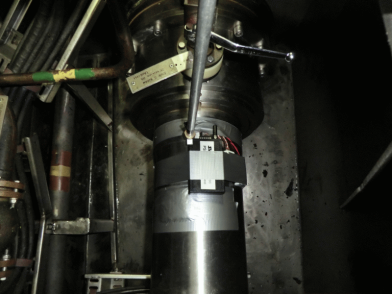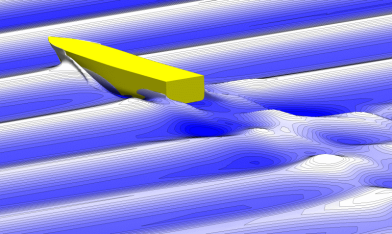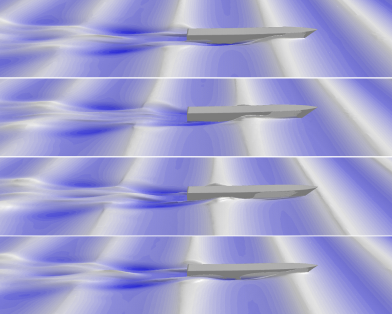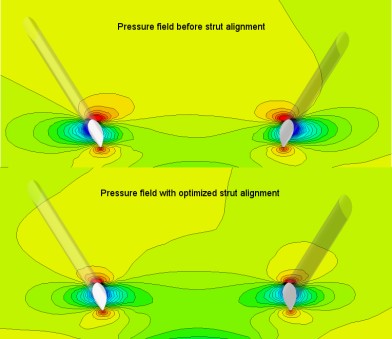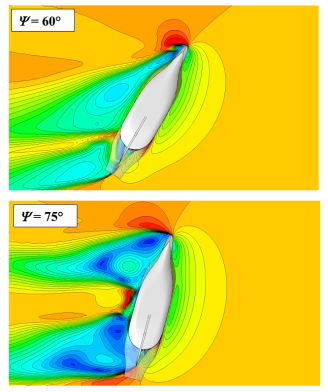
The use of numerical calculation methods offers many possibilities to investigate ship manoeuvres. In general, numerical calculations analogous to PMM-experiments (Planar Motion Mechanism) are carried out in which static and dynamic simulations are performed to determine the forces and moments as a function of a specific movement of the ship. From this, the hydrodynamic coefficients can be derived and fed into a mathematical model. With the calculation of a complete set of hydrodynamic coefficients, any manoeuvre can be simulated. To verify the quality of the numerical calculations, the calculation results are continually validated with the corresponding measured values.
Numerical simulations allow to:
- Simulate manoeuvring behaviour in model and full-scale
- Simulation of static and dynamic tests
- Visualisation of flow, detection of separating flow
- Design of control elements such as rudders, thrusters, etc.
The rudder is by far the most frequently used control element; it operates in the wash of the propeller. Below, the pressure distribution on the rudder for a rudder angle of δR = 20° with a rotating propeller is shown.
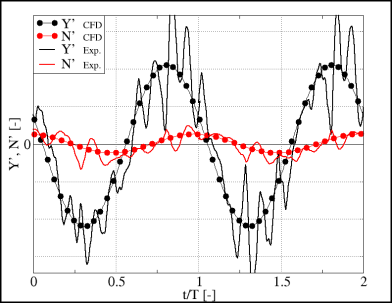
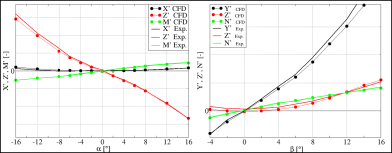
Context Related References / Research Projects
[1] Lübke, L.: Investigation of a Semi-Balanced Rudder, 10th Numerical Towing Tank Symposium, Hamburg, 24.09.2007
[2] Lübke, L.: Investigation of a Semi-Balanced Rudder, 14. SVA Forum, Potsdam, 07.11.2007
[3] Lübke, L.: Investigation of a Semi-Balanced Rudder, ANSYS Conference & 25th CADFEM Users Meeting 2007, Dresden, 21. – 23.11.2007
[4] Lübke, L.: Numerische und experimentelle Untersuchungen an einem Halbschweberuder, STG-Sprechtag, Verbesserung der Propulsions- und Manövriereigenschaften von Schiffen, Papenburg, 18.09.2008
[5] Lübke, L.: Numerische PMM-Tests für Unterwasserfahrzeuge, ANSYS Seminar, Simulationswerkzeuge für die Marine und Offshore Industrie, Hamburg, 05.11.2008
[6] El Moctar, O., Brehm, A., Lübke, L.: Hydrodynamische und strukturmechanische Untersuchung von Rudern großer, schneller Schiffe (XXL-Ruder), PTJ Statustagung, Warnemünde, 11.12.2008
[7] Lübke, L.: Numerische und experimentelle Untersuchungen der effektiven Ruderzuströmung beim Manövrieren, 2. SVA Forschungsforum „Theoria cum praxi“, Potsdam, 29.01.2009
[8] Lübke, L.: Manoeuvering Simulations of Underwater Vehicles, 12th Numerical Towing Tank Symposium, Cortona Italy, 04.-06.10.2009
[9] Lübke, L.: Investigation of a Semi-balanced Rudder, Ship Technology Research, Vol. 56, No. 2, 2009
